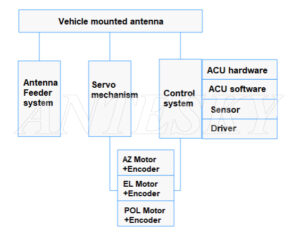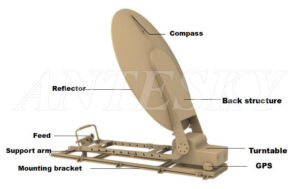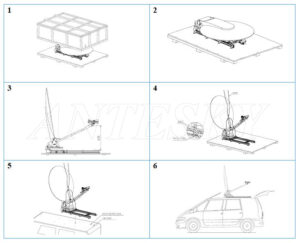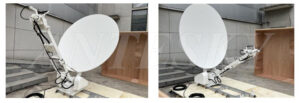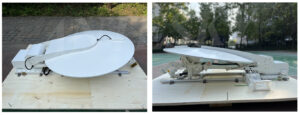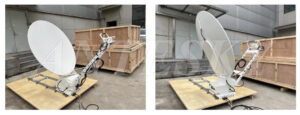In order to better receive satellite signals on the vehicle, a satellite signal receiving device is needed. Vehicle-mounted Drive Away SNG Antenna systems came into being. The vehicle-mounted antenna is designed using automatic control and computer technology. By controlling the steering and rotation speed of the stepper motor, the receiving antenna is controlled to rotate in a certain direction, changing the azimuth and elevation angles of the antenna, so that the satellite antenna can accurately point to the satellite’s orientation.
The electromagnetic resonance between the beacon receiver and the satellite’s electrical signal will be the strongest, ensuring clear and stable received signals.
Vehicle-mounted Drive Away SNG Antennas are increasingly used in the communications field because they are not subject to geographical restrictions and are flexible and mobile. This Vehicle-mounted satellite antenna system requires that when the car is parked at any outdoor location, the antenna quickly and automatically captures the satellite in order to realize the transmission of data, voice, and images.
The Vehicle-mounted Drive Away SNG Antennas needs to receive TV satellite signals at a fixed location. The vehicle-mounted satellite antenna control system must be equipped with an advanced global positioning system and electronic compass, which can capture and track satellites in an all-round, accurate and fast manner.
Before introducing the vehicle antenna control and tracking system in detail, it is first necessary for us to understand the current satellite navigation systems.
At present, in addition to China’s Beidou satellite navigation system, there are two major global satellite navigation and positioning systems operating in the world: one is the Global Positioning System (GPS) of the United States, and the other is Russia’s Glona Global Navigation Satellite System (GLONASS). In recent years, the European Union is also building its own unique Galileo Positioning System (Galileo).
Each of the four major satellite navigation systems has its own characteristics: GLONASS has higher civilian accuracy. GPS can only find streets, but Galileo can find garage doors. Beidou can let others know your location through text messages, which other navigation systems currently do not have.
four major satellite navigation systems
Global Positioning System (GPS) of the United States
The GPS positioning system is a satellite radio navigation system, which consists of the space part, the ground monitoring part and the user receiver. The space part of GPS is composed of 21 working satellites and 3 backup satellites. It is located 20200 km above the earth’s surface, evenly distributed on 6 orbital planes, with an orbital inclination of 55°. The distribution of satellites allows more than 4 satellites to be observed anywhere in the world at any time, and navigation information can be pre-stored in the satellites. The ground monitoring part mainly consists of 1 main control station, 3 injection stations, and 5 monitoring stations. It is mainly responsible for collecting information returned by satellites and calculating satellite ephemeris, relative distance, atmospheric correction and other data. The user receiver mainly receives signals transmitted by GPS satellites, obtains necessary navigation and positioning information, and completes positioning, navigation, tracking, mapping and timing work through signal transformation, amplification and processing.
At present our Antesky Vehicle-mounted Drive Away SNG Antennas adopt this type of GPS positioning system.
Russia’s Glona Global Navigation Satellite System (GLONASS)
The construction of GLONASS was started by the former Soviet Union in 1976. The official network was established earlier than GPS. After the disintegration of the former Soviet Union, GLONASS was operated by the Russian government.
Similar to the composition of GPS, GLONASS is also composed of three parts: the space constellation part, the ground monitoring part and the user equipment part. The GLONASS space constellation consists of 27 working stars and 3 backup stars. The 27 stars are evenly distributed on 3 nearly circular orbital planes. These 3 orbital planes are 120° apart, and each orbital plane has 8 Satellites in the same plane are separated by 45°, with an orbital altitude of 23,600 km and an orbital inclination of 56°. The ground monitoring part consists of the system control center, central synchronizer, telemetry and remote control station (including laser tracking station) and field navigation control equipment. The system control center and central synchronization processor are located in Moscow, and the telemetry and remote control stations are located in St. Petersburg, Ternopil, Enisesk and Komsomolsk. The user equipment of GLONASS, that is, the receiver, can receive navigation signals transmitted by satellites. The receiver processor processes the above data and calculates the user’s location, movement speed and time information.
Our Antesky can customize Vehicle-mounted Drive Away SNG Antennas as GLONASS positioning system.
Galileo Positioning System (Galileo) in European Union
Galileo is a satellite positioning system under construction by the European Union. Galileo consists of three parts: the space segment, the ground segment, and the user segment. The space segment consists of 30 medium-altitude orbiting satellites (MEO) distributed on 3 orbital planes. There are 10 satellites on each orbital plane, 9 of which are in normal operation and 1 of which is in reserve; the orbital plane has an inclination angle of 56°. The ground segment includes the global ground control segment, global ground mission segment, global area network, navigation management center, ground support facilities and ground management agencies. The user end is mainly a user receiver and its equivalent products. Galileo considers forming a composite satellite navigation system together with the navigation signals of GPS and GLONASS. Therefore, its user receiver will be a multi-purpose and compatible receiver. A typical function of Galileo is signal relay, that is, data transmission to the user’s receiver can be achieved through a special contact method or relay in other systems, such as through a mobile communication network. Galileo’s receiver can not only accept signals from this system, but also signals from the two major systems of GPS and GLONASS. It also has the superior performance of combining navigation functions with mobile phone functions and with other navigation systems.
Our Antesky can also customize Vehicle-mounted Drive Away SNG Antennas as Galileo positioning system.
Through the combined use of signals from the Global Positioning System, Beidou, GLONASS, and Galileo, it can not only improve positioning accuracy, but also free users from dependence on a specific navigation constellation. The usability is greatly enhanced. Multi-system combination receivers have many good development prospects.
Antesky is professional in manufacturing and supplying satellite communication equipment for years. Today, let us show you more about our vehicle mounted drive away SNG antenna.The 1.2 meter and 1.8 meter vehicle mounted drive away SNG antenna ordered by the customer this time can support GPS and GLONASS positioning and navigation at the same time, which greatly broadens the scope of use and is more practical.
General introduction of Antesky vehicle mounted drive away SNG antenna system
Antesky vehicle mounted drive away SNG antenna system mainly consists of antenna feeder system, servo mechanism, and control system, as shown below. The antenna feeder system is the core of antenna operation, and the electrical performance indicators are mainly guaranteed by this part. It is generally composed of antenna reflector, feed horn, LNB, power amplifier, duplexer, and waveguide components.
Vehicle mounted drive away SNG antenna composition
Servo mechanism mainly refers to the turntable part of the antenna, generally composed of transmission mechanism (gears, belts, reducers, worm gears, etc.) and motor.
The control system is divided into two parts, one is located outside the vehicle, called the APTC controller, and the other is located inside the vehicle, called the ACU antenna control unit. The APTC controller and ACU controller communicate through RS422 bus connection.
Product features of Antesky vehicle mounted drive away SNG antenna system
a) Easy disassembly and assembly, stable structure, superior performance, fast star finding, and high safety.
b) The configured GPS has high accuracy and the electronic compass has strong anti-interference performance, ensuring the stability and accuracy of the satellite alignment function.
c) The antenna’s automatic aiming to satellite time does not exceed 3 minutes (RMS).
d) It has multiple protection functions such as automatic warning, mechanical limit, and software limit, making the antenna operation safer.
The detailed installation process diagram is shown below.
Detailed installation process of Antesky vehicle mounted drive away SNG antenna system
Some vehicle mounted drive away SNG antennas display shown below.
1.8m vehicle mounted drive away SNG antenna with Ku band
1.2m C band vehicle mounted drive away SNG antenna
1.2m Ka band vehicle mounted drive away SNG antenna
Currently, 2 sets of 1.8m and 1.2m vehicle mounted drive away SNG antennas are shipping to client’s site. We will keep you updated once they received and in operation.
And for the antenna tracking system of Vehicle Mounted Drive Away SNG Antenna, if you have special requirement, we can do the customization based on your detailed request.
Please contact with us inquiry via sales@antesky.com. to learn more technical data about vehicle mounted drive away SNG antenna.We will offer you the high quality antenna with the best price.Thanks!


